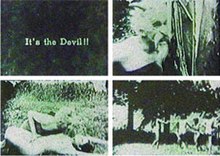Stag film
[3] American stag cinema in general has received scholarly attention first in the mid-seventies by mainstream scholars, such as in Di Lauro and Gerald Rabkin's Dirty Movies (1976), and more recently by feminist and gay cultural historians, such as in Linda Williams' Hard Core: Power Pleasure, and the "Frenzy of the Visible" (1999) and Thomas Waugh's Homosociality in the Classical American Stag Film: Off-Screen, On-screen (2001).
Stag films were an entirely clandestine phenomenon; not until the "porn chic" era of the 1970s would sexually explicit cinema gain any recognition or discussion in mainstream society.
Stag films persisted for such a great length of time, as Williams argues, simply because they were cut off from more public scrutiny of sexual behavior.
[11] In his essay, Waugh argues that "the stag films, both on-screen and off-screen, are tenaciously engaged with the homosocial core of masculinity as constructed within American society.
Waugh would argue that this mentality and this corpus of underground erotic film "exposes the spectrum of male sociality, the experience of having a penis, and being white during the first two-thirds of the 20th century.
Waugh also contends that there are a few subversions in this dynamic, describing one film, the cartoon Buried Treasure (c. 1928), as an "overt interrogation of masculinity.

